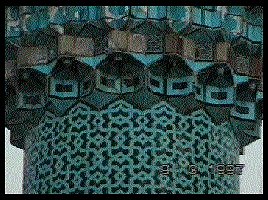
The Haci Özbek Mosque with its single dome represented Iznik’s Turkish Period masterpieces and was considered to be a pioneering effort in the development of Ottoman mosques.  The Yesil (Green) Mosque, which was built between 1378-91, is regarded as the most important mosque in Iznik in which Candarli Halil Pasha commissioned Architect Haci Musa to complete the work. The Yesil (Green) Mosque, which was built between 1378-91, is regarded as the most important mosque in Iznik in which Candarli Halil Pasha commissioned Architect Haci Musa to complete the work. The Nilüfer Hatun Hospice was constructed next to the Green Mosque in 1388 and was named after the mother of Sultan Murat I, Nilüfer Hatun. Today, it is used as an ARCHAEOLOGY MUSEUM.(click on the pic.right,to see the full size image of the Museum)   In addition, some of Iznik’s historical mosques are the Orhan Gazi Mosque, built in 1334, the Mahmut Celebi Mosque, built in 1442, the Seyh Kubbeddin Mosque, which dates from the beginning of the 15th century, the Suleyman Pasha Complex, which dates back to the 14th century and the Yakup Celebi Mosque, which was commissioned by the son of Murat I, Yakup Celebi, in the year 1380. Click the link for the pictures of IZNIK ARCHAEOLOGY MUSEUM The fabulous Iznik tiles that were created in workshops along Lake Iznik in the 15-17th centuries were used in the structures of that age and earned the amazement of the entire world. Today masterpieces originating from Iznik, such as the porcelain tiles that decorate numerous mosques, tombs, palaces and villas along with porcelain plates and oil lamps are on display in museums in Turkey and throughout the world.     The Characteristics of IZNIK Tiles  Iznik Tiles are made on a very clean white base with hard backs and under-glaze decorations in a unique technique. Iznik Tiles are made on a very clean white base with hard backs and under-glaze decorations in a unique technique.70-80 percent of an Iznik tile is composed of quartz and quartzite. Its beauty arises from the harmonious composition of three successive quartz layers and a paste-slip-glaze combination that is extremely difficult to bring together. The mixture of quartz, clay and glaze disperses in a very wide thermal spectrum at 900 centigrade. After painstaking research, the problem of the fluctuating thermal behavior of the tiles due to their quartz and rock crystal composition was solved. The result; a tile made primarily out of a semi-precious stone, quartz. Even though it may appear to be against the principle of "ceramic textural unity", the unique structure of the tiles cause dilatation in hot, and shrinkage in cold or freezing conditions. Iznik tiles are extremely durable, and versatile for any decorative or architectural concept.  In Iznik tiles, one can observe colors resembling those of semi-precious stones such as the dark blue of lapis lazuli, the blue of turquoise, the redness of coral, and the green of emerald.
In Iznik tiles, one can observe colors resembling those of semi-precious stones such as the dark blue of lapis lazuli, the blue of turquoise, the redness of coral, and the green of emerald. Some of the colors observed on the tiles and utensils, particularly the coral red, are very hard to obtain and apply. To obtain all of these colors, the cornea white and opaque sheen glazes are required. The slightly opaque quality of the glaze on the tiles cushions reflective light, producing a relaxing expression. The figures on the tiles and utensils reflect allegorical and symbolic characteristics, namely the flora and fauna of the region. The geometrical designs can be interpreted cosmologically as a general description or depiction of the world or the Universe. Iznik Tiles are never overpowering or overstated, and tend towards a timeless discretion and moderation,blending beautifully with surrounding architecture. The old masters kept their production techniques very secret, even from their own families and students. They took production secrets of their manufacture lay concealed for centuries. Unlike current ceramic technologies, our production is fundamentally based on the natural synthesis of its various components. This intensely difficult ceramic production process is made possible through the synthesis of human labor, creativity and patience. IZNIK Tiles Today Iznik Kiln excavations that have been carried out for over 20 years by Archeology and history Departments of Istanbul University, gives us clues as to the types of kilns and ceramics used in the Art of Iznik tile making.   The Iznik Foundation has received the support of scientific foundations and NGO's such as TUBITAK - MAM (Turkish Scientific Research Institute - Marmara Research Center, I.T.U. (Istanbul Technical University), I.U. (Istanbul University), in Turkey, in a vast range of analysis.     Old Iznik tiles reached their heyday in the 16th century, and the masterpieces produced at that time are regarded as the most valuable specimens in the art of ceramics by the leading museums of the world. Currently, Iznik Tiles are used as an architectural element in old and modern buildings by the discriminating decorators, architects and art lovers.
[
Sign my Guestbook] - [Read my Guestbook
] MATHEMATICIANS and the COINS of IZNIK 





 

 |